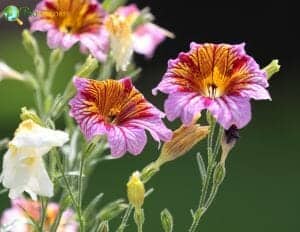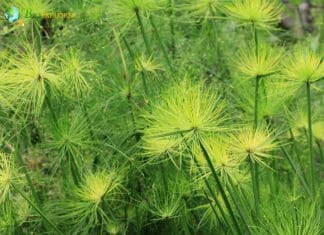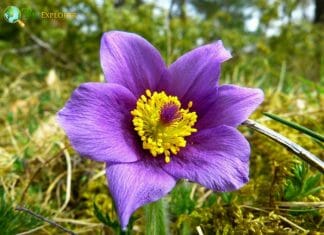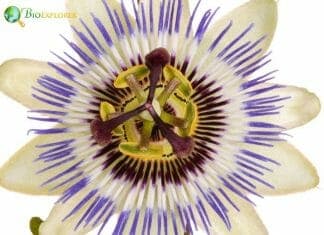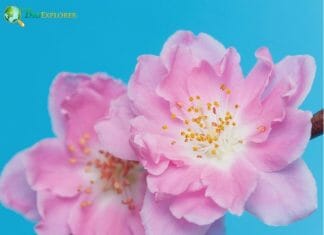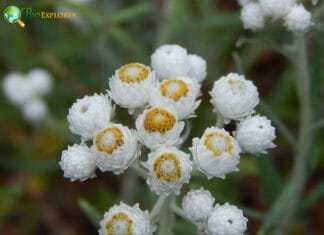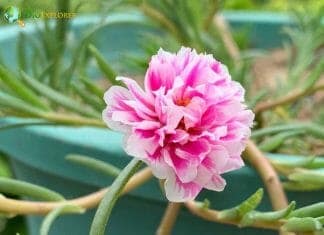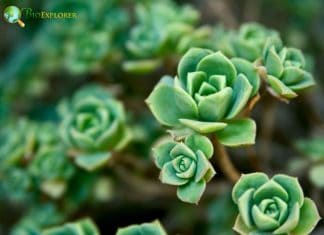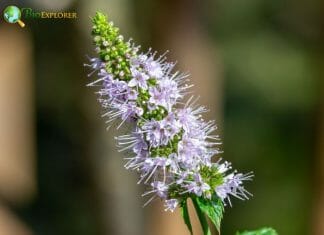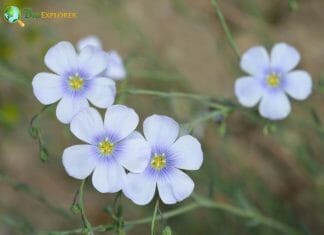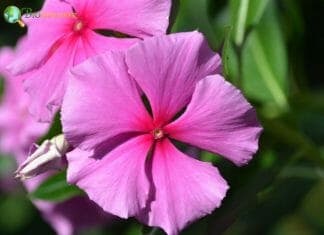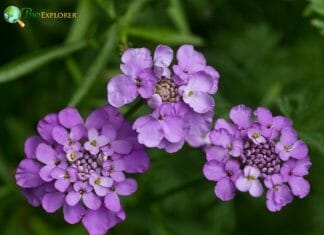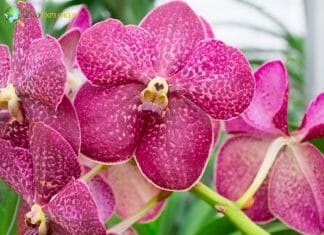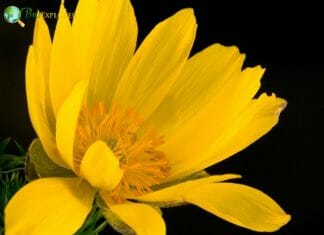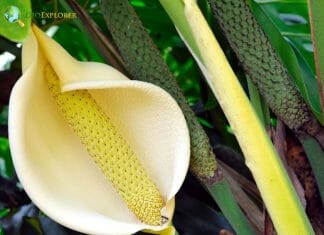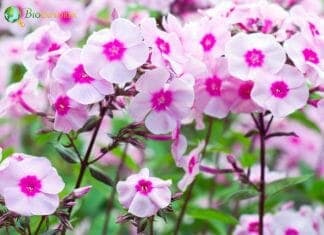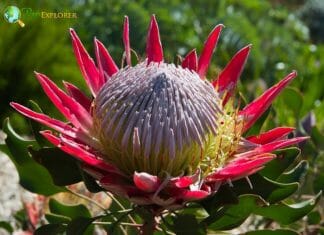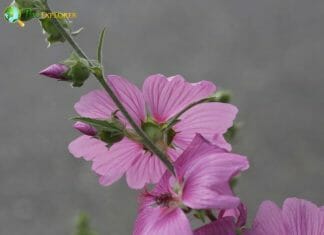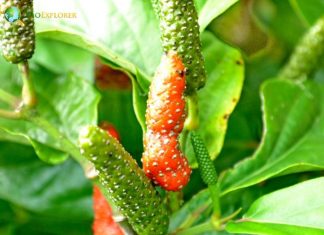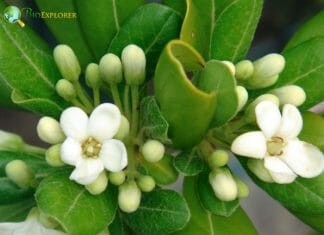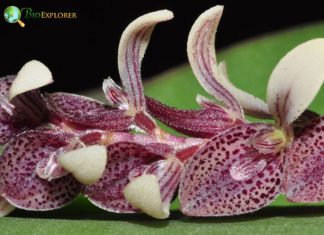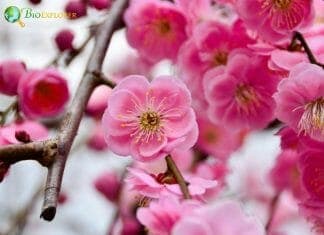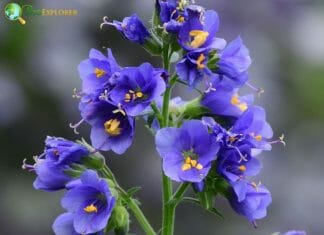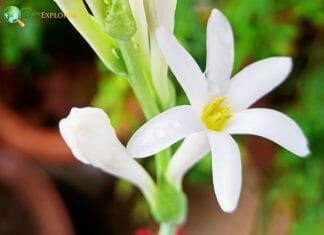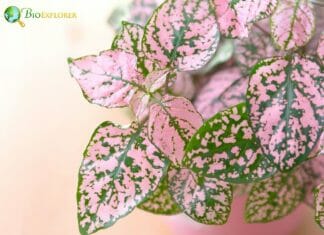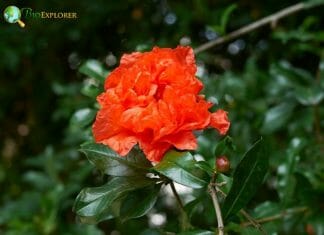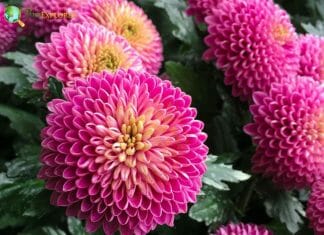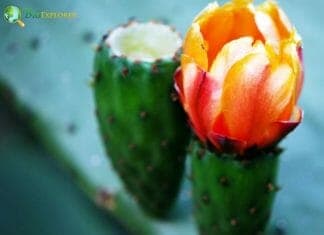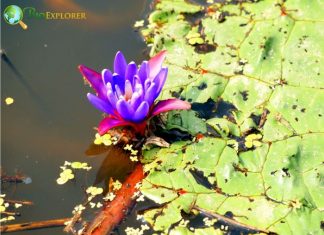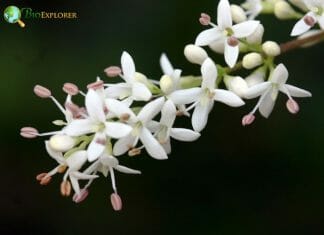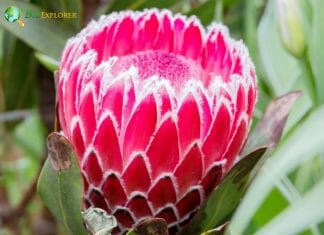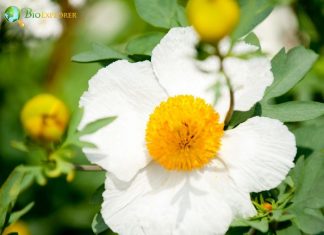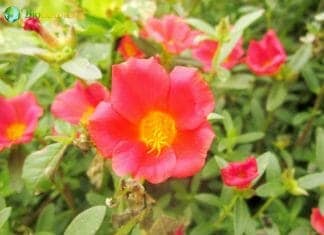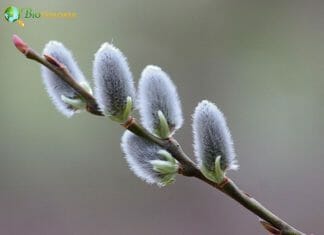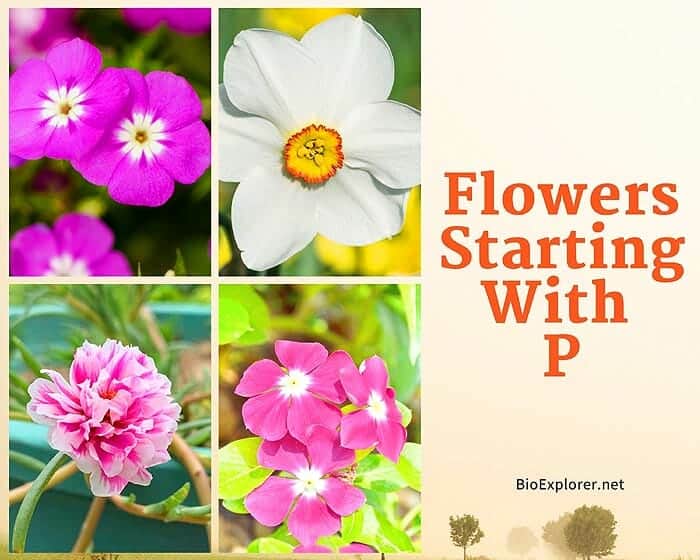
Turn any garden into fragrant heaven with sweet-scented Persian Candytuft, Phlox, and Polemonium flowers. Though these are technically annuals, they can be planted throughout the year and bloom from spring to fall. Persian Candytuft will produce a profusion of flowers and attractive foliage in just one season.
On the other hand, Phlox is a long-lived perennial that typically grows 2-3 feet tall. Its showy flowers make it an easy choice for any garden setting. Polemonium’s delicate purple blossoms provide interest throughout the entire growing season.
Explore the world of all sorts of flowers starting with P.
Flowers Starting with P
Here are the flowers starting with the letter P.
Painted Tongue
Flower Type: Annuals/Perennials
The relative of the petunia, the painted tongue (Salpiglossis sinuata), catches the eye with its spectacular trumpet-shaped blooms in shades of deep violet, gold, and magenta.
Paper Reed
Flower Type: Perennials
Cyperus papyrus, also called paper reed or Egyptian reed, is an African tufted species native to the southern Mediterranean, the wettest parts of Africa, and Madagascar. It is a dense collection of many bright green thread-like rays. Tiny secondary umbels are formed with 3 to 5 rays and elongated, narrow bracts at the tips of the rays.
Pasque flower
Flower Type: Perennials
As a harbinger of spring, the pasque flowers (Pulsatilla vulgaris) begin to appear before the plant's fern-like, feathery foliage has fully developed. The flowers are usually purple, but some cultivars also have red, pink, or white flowers.
Passionflower
Passionflowers are a genus of around 500 species characterized by a characteristic pattern of radiant filaments and tiered structures. Passionflowers are around 3 inches in diameter and are usually white, pink, blue, purple, red, or multi-colored.
Peach blossom
Flower Type: Shrubs/Trees
The common peach blossom (Prunus persica) is the genus Prunus fruit plant, which belongs to the Rosaceae family. The Prunus genus includes 430 different tree and shrub species. The peach blossom originates from northern and central China.
Pearly Everlasting
Anaphalis margaritacea, commonly known as Pearly Everlasting, is a native North American plant that grows up to 3 feet tall and is usually found in sandy, dry, or gravelly locations. It is an erect, tufted plant with attractive, woolly, narrow, silvery-gray leaves and tiny, white, spherical flowers with yellow central stamens.
Peony
Flower Type: Perennials
Peony is a Japanese easy-care flowering plant in the genus Paeonia of the Paeoniaceae family. The genus consists of approximately 32 species of wild peonies primarily native to Europe, Asia, and western North America. The flowers range in color from pink and purple to red, yellow, or white. The flowers bloom from late spring to early summer.
Peperomia
Flower Type: Perennials
Peperomia is one of the two main genera of the Piperaceae family. Most are small, compact perennial epiphytes that grow on rotten wood. Over 1,500 species have been recorded in all subtropical and tropical regions worldwide. Typically, Peperomia flowers appear in brown, yellow, or green conical spikes.
Peppermint
Flower Type: Perennials
Peppermint (Mentha × piperita, also called Mentha balsamea) is a hybrid mint, a cross of spearmint and watermint. Native to the Middle East and Europe, the plant is now widespread and grown in many parts of the world. The axis of the stem is usually hairy and usually highly branched. Peppermint flowers can be purple, pink, and sometimes white.
Perennial Flax
Flower Type: Perennials
Linum perenne, commonly known as perennial flax, is a short-lived perennial shrub native to Europe that generally grows 1 to 2 feet tall. Linum is a genus of around 200 species of flowering plants. It blooms profusely for up to eight weeks in late spring. The sky-blue flowers open early in the sunny mornings, but the petals usually fall in the late afternoon.
Periwinkle
Vinca minor, commonly called periwinkle or Vinca, is among the most popular and primarily used groundcovers. Periwinkle is a species of the Apocynaceae (oleander) family native to Southern and Central Europe. Phlox-like, tubular, red-violet, pink, or lavender-blue flowers (up to 1 inch wide) appear in spring in the leaf axils and bloom intermittently from summer through fall.
Persian Candytuft
Flower Type: Perennials
Commonly known as Persian candytuft or Persian watercress, Aethionema is a genus of around 60 Brassicaceae (mustard) family species. Persian candytuft is magnificent Old-World watercress cultivated for its fragrant pink flowers.
Phalaenopsis
Phalaenopsis is a genus of approximately 45 species of primarily epiphytic orchids native to Southeast Asia, southern China, and India. The conspicuous, flattened blooms (each 3 to 6 inches wide) appear in long sprays on arched stems in various colors, including pinkish-purple, yellow, cream, pale yellow, and white.
Pheasant’s eye
Flower Type: Perennials
Adonis vernalis, commonly known as pheasant's eye features upright, columnar, branching, leafy stems that average 8 to 24 inches tall. The typical width of the plant is 6 to 12 inches. The blooms are small and resemble buttercups, varying in color from yellow, orange, scarlet, or purple.
Philodendron
The philodendron isn't a plant per se, as widely believed, but a plant genus botanically known as Araceae. Its great popularity is due to its simplicity. The foliage of the philodendron is usually green, but it can be coppery, purple, or red. The long, white part of the blossom is known as the spadix.
Phlox
Flower Type: Annuals/Perennials
As the mainstay of the cottage garden, Phlox owes its continued popularity to its puffy flower clouds and simple nature. Phlox is a genus of about 67 species of annual and perennial plants in the Polemoniaceae family. The lightly scented flowers can be white, bright red, light blue, pink, or purple.
Pink Musk
Flower Type: Perennials
Malva moschata, the pink musk mallow, is a plant species in the Malvaceae family native to Southwest Asia and Europe. This pink wildflower is grown for its fragrant flowers that thrive during the summer months. The pink-musk flowers are in clusters in the axils of the leaves, each flower 3.2 to 5 cm in diameter, with 5 bright pink petals at the notched to truncated end.
Piper
Flower Type: Shrubs/Trees
Piper is an ecologically and economically important genus of the Piperaceae family. It includes around 1,000 to 2,000 species of lianas, herbs, and shrubs, many of which are dominant in their natural habitat. The Piper flowers bloom in early summer. They are slightly purple to white in color and hang in a bell shape.
Pittosporum
Flower Type: Shrubs/Trees
Pittosporum is one of many evergreen trees or shrubs primarily native to New Zealand and Australia, making up the Pittosporaceae family's Pittosporum genus. Also known as Australian laurel, Pittosporum is mainly planted as ornamental plants in temperate regions
Pleurothallis
Pleurothallis is a genus in the family Orchidaceae (orchids) native to America's temperate and tropical regions. Several species are called bonnet orchids and are cultivated for their showy hooded flowers. The blossoms can have a delicate or thick structure; cymes can be single or multi-flowered, very long to short. Currently, more than 1000 species of flowering plants are described.
Plum Blossom
Flower Type: Trees
Plum blossom is a deciduous, rounded tree from Japan with great ornamental value. It can grow from 4 to 10 meters in height. The ume flower in pale pink or white blossoms signifies faithfulness, purity of heart, and classiness.
Polemonium
Flower Type: Perennials
Jacob's ladder (Polemonium caeruleum) is a perennial species of the Polemoniaceae family. It is native to the temperate regions of Asia and Europe, where it grows mainly in meadows, grasslands, and damp forests. They are available in yellow, blue, white, or pink, depending on the variety.
Polianthes tuberosa
Flower Type: Perennials
Polianthes tuberosa, commonly known as tuberose, is possibly native to Mexico. It's considered iconic and has a long cultural history dating back to pre-Columbian times. The Agave genus (Agavaceae) includes about 200 species.
Polka Dot Plant
Flower Type: Shrubs
Polka Dot Plants (Hypoestes phyllostachya) are common houseplants with brightly colored leaves. Also known as the freckle face plant, the Polka dot plant is an evergreen shrub native to East Asia, South Africa, and Madagascar.
Pomegranate
Flower Type: Shrubs/Trees
The pomegranate (Punica granatum) is a fruity, deciduous shrub from the Lythraceae family, a subfamily of the Punicoideae. The flowers are typically bright red but can also be pink or white and are 3 cm (1.18 inches) in diameter with 4 to 5 petals.
Pompom Chrysanthemum
Flower Type: Annuals
Pompom blooms are annual flowering plants better known as chrysanthemums. The flowers are known as pompoms because their fullness makes them look like the pompoms used by cheerleaders. Pompom flowers are native to China. Flowers are sometimes seen in ancient Chinese art.
Poppy
Flower Type: Biennials
The Poppy is a flowering herbaceous plant of the Papaveroideae subfamily in the Papaveraceae family. Papaver somniferum is the source of narcotic opium, which contains potent medicinal alkaloids and has been used as an analgesic and medicinal and recreational anesthetic since ancient times.
Prickly pear
Flower Type: Perennials
The prickly pear, Opuntia ficus-indica, has established itself in different parts of the world where it is not native. In fact, it is so widespread that its original native habitat is unknown, although it is likely native to Mexico. Prickly pears can reach a height of 1.5 meters (5 feet) and can grow to a diameter of 4.5 meters (15 feet).
Prickly Water Lily
Flower Type: Annuals/Perennials
Euryale ferox is a species of water lily found in Asia. The Prickly Water Lily is a perennial plant in the order of Nymhaeales. The seeds of the Prickly Water Lily are used in Chinese traditional medicine. A study showed that extracts from Euryale ferox manifest antioxidant activity.
Primrose
Flower Type: Annuals/Perennials
With over 400 species to select from, these cheerful spring plants are available in a rainbow of colors. As you can imagine, the flowers' shapes, sizes, and colors vary. The common primrose (Primula vulgaris) is a species in the Primulaceae family native to northwestern Africa, southern and western Europe, and parts of southwestern Asia.
Privet
Flower Type: Shrubs/Trees
Privet (Ligustrum vulgare), with its glossy dark green foliage, forms a dense living fence or privacy hedge. These plants can be deciduous, semi-evergreen, or evergreen, depending on the variety you choose and where you live. The genus includes around 50 species of upright, evergreen, or deciduous shrubs, which often form medium-sized to small trees and are native to Asia, North Africa, and Europe.
Protea
Flower Type: Shrubs/Trees
Proteas are found throughout the mountain ranges of Australia and South Africa, appearing in all their glory in various regions. Protea is a genus of plants also known as maples. Protea leaves are hard and leathery. The inflorescence of the protea flower can be described as cup-shaped, calyx-shaped, or bowl-shaped.
Purslane
Flower Type: Annuals
Purslane (Portulaca grandiflora) is a heat and drought tolerant annual plant native to the hot, arid plains of Uruguay, Argentina, and southern Brazil. Purslane is among the 3 most important species of portulaca. It has several common names, including rock rose, the sun rose, Mexican rose, eleven o'clock, and rose moss.
Pussy Willow
Flower Type: Shrubs/Trees
Pussy Willow (Salix discolor) is a name for many smaller species in the Salix genus (sallows and willows) when their hairy catkins are young at the beginning of spring. Salix discolor, the American willow or glaucous willow, is one of the two species commonly known as pussy willow.
Cite This Page
APA7MLA8Chicago
BioExplorer.net. (2025, April 14). Flowers Starting with P. Bio Explorer. https://www.bioexplorer.net/plants/flowers/p/.
BioExplorer.net. "Flowers Starting with P" Bio Explorer, 14 April 2025, https://www.bioexplorer.net/plants/flowers/p/.
BioExplorer.net. "Flowers Starting with P" Bio Explorer, April 14 2025. https://www.bioexplorer.net/plants/flowers/p/.


